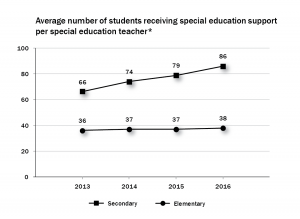Special education supports in Ontario’s schools
Special education funding changes in Ontario may result in improved access and better programs, but there is currently no information available about the impact of the changes.
In 2014, the Ministry of Education began phasing in significant changes to the funding model to support students with higher special education needs. The changes have resulted in increases in special education funding in some boards and reductions in others.
Data from People for Education’s annual report on schools show that in 2016:
- an average of 17% of students in each elementary school and 27% of students in each secondary school receive some special education support.
- 26% of elementary schools report that not all students are receiving recommended special education support, an increase from 22% last year.
- 59% of elementary and 52% of secondary schools report that there are restrictions on the number of students they can place on waiting lists for assessments.
- The ratio of special education students to special education teachers is 38:1 in elementary schools and 86:1 in secondary schools.
Schools in small town/rural communities are further challenged in meeting students’ needs:
- 72% of small town/rural schools report restrictions on the number of students that can be placed on waiting lists for assessments, compared to 50% of schools in urban/suburban areas.
- Only 66% of small town/rural elementary schools have a full-time special education teacher, compared to 91% of urban/suburban elementary schools.

